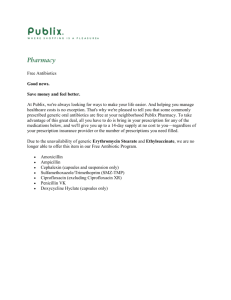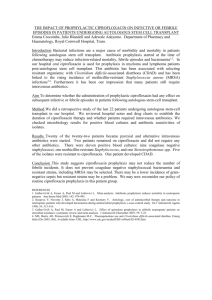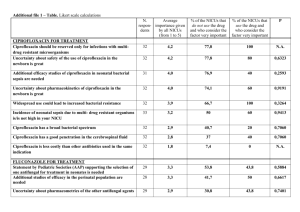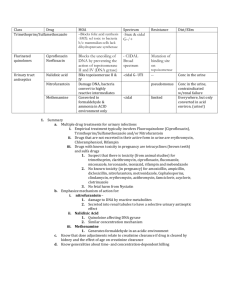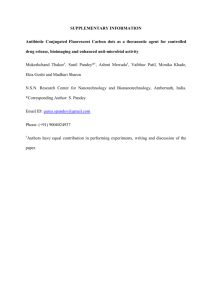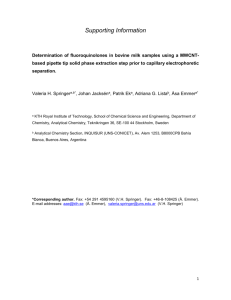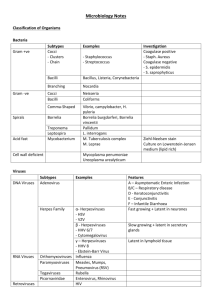Ciprofloxacin Amneal 500 mg
advertisement
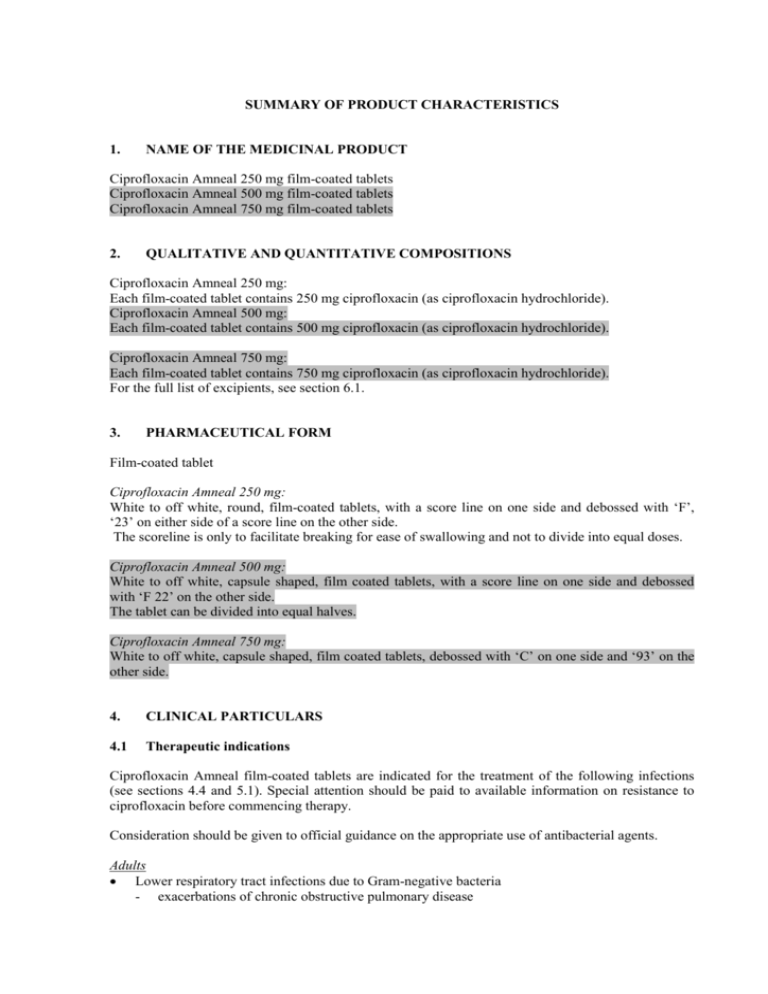
SUMMARY OF PRODUCT CHARACTERISTICS
1.
NAME OF THE MEDICINAL PRODUCT
Ciprofloxacin Amneal 250 mg film-coated tablets
Ciprofloxacin Amneal 500 mg film-coated tablets
Ciprofloxacin Amneal 750 mg film-coated tablets
2.
QUALITATIVE AND QUANTITATIVE COMPOSITIONS
Ciprofloxacin Amneal 250 mg:
Each film-coated tablet contains 250 mg ciprofloxacin (as ciprofloxacin hydrochloride).
Ciprofloxacin Amneal 500 mg:
Each film-coated tablet contains 500 mg ciprofloxacin (as ciprofloxacin hydrochloride).
Ciprofloxacin Amneal 750 mg:
Each film-coated tablet contains 750 mg ciprofloxacin (as ciprofloxacin hydrochloride).
For the full list of excipients, see section 6.1.
3.
PHARMACEUTICAL FORM
Film-coated tablet
Ciprofloxacin Amneal 250 mg:
White to off white, round, film-coated tablets, with a score line on one side and debossed with ‘F’,
‘23’ on either side of a score line on the other side.
The scoreline is only to facilitate breaking for ease of swallowing and not to divide into equal doses.
Ciprofloxacin Amneal 500 mg:
White to off white, capsule shaped, film coated tablets, with a score line on one side and debossed
with ‘F 22’ on the other side.
The tablet can be divided into equal halves.
Ciprofloxacin Amneal 750 mg:
White to off white, capsule shaped, film coated tablets, debossed with ‘C’ on one side and ‘93’ on the
other side.
4.
CLINICAL PARTICULARS
4.1
Therapeutic indications
Ciprofloxacin Amneal film-coated tablets are indicated for the treatment of the following infections
(see sections 4.4 and 5.1). Special attention should be paid to available information on resistance to
ciprofloxacin before commencing therapy.
Consideration should be given to official guidance on the appropriate use of antibacterial agents.
Adults
Lower respiratory tract infections due to Gram-negative bacteria
- exacerbations of chronic obstructive pulmonary disease
- broncho-pulmonary infections in cystic fibrosis or in bronchiectasis
- pneumonia
Chronic suppurative otitis media
Acute exacerbation of chronic sinusitis especially if these are caused by Gram-negative bacteria
Urinary tract infections
Gonococcal uretritis and cervicitis
Epididymo-orchitis including cases due to Neisseria gonorrhoeae
Pelvic inflammatory disease including cases due to Neisseria gonorrhoeae
In the above genital tract infections when thought or known to be due to Neisseria gonorrhoeae it is
particularly important to obtain local information on the prevalence of resistance to ciprofloxacin and
to confirm susceptibility based on laboratory testing.
Infections of the gastro-intestinal tract (e.g. travellers’ diarrhoea)
Intra-abdominal infections
Infections of the skin and soft tissue caused by Gram-negative bacteria
Malignant external otitis
Infections of the bones and joints
Treatment of infections in neutropenic patients
Prophylaxis of infections in neutropenic patients
Prophylaxis of invasive infections due to Neisseria meningitidis
Inhalation anthrax (post-exposure prophylaxis and curative treatment)
Children and adolescents
Broncho-pulmonary infections in cystic fibrosis caused by Pseudomonas aeruginosa
Complicated urinary tract infections and pyelonephritis
Inhalation anthrax (post-exposure prophylaxis and curative treatment)
Ciprofloxacin may also be used to treat severe infections in children and adolescents when this is
considered to be necessary.
Treatment should be initiated only by physicians who are experienced in the treatment of cystic
fibrosis and/or severe infections in children and adolescents (see sections 4.4 and 5.1).
4.2
Posology and method of administration
Posology
The dosage is determined by the indication, the severity and the site of the infection, the susceptibility
to ciprofloxacin of the causative organism(s), the renal function of the patient and, in children and
adolescents the body weight.
The duration of treatment depends on the severity of the illness and on the clinical and bacteriological
course.
Treatment of infections due to certain bacteria (e.g. Pseudomonas aeruginosa, Acinetobacter or
Staphylococci) may require higher ciprofloxacin doses and co-administration with other appropriate
antibacterial agents.
Treatment of some infections (e.g. pelvic inflammatory disease, intra-abdominal infections, infections
in neutropenic patients and infections of bones and joints) may require co-administration with other
appropriate antibacterial agents depending on the pathogens involved.
Adults
Indications
Daily dose in mg
Infections of the lower respiratory tract
500 mg twice daily
to
750 mg twice daily
500 mg twice daily
7 to 14 days
to
750 mg twice daily
500 mg twice daily
7 to 14 days
to
750 mg twice daily
750 mg twice daily
28 days up to 3 months
250 mg twice daily
3 days
to
500 mg twice daily
In pre-menopausal women, 500 mg single dose
may be used
500 mg twice daily
7 days
Infections of the
upper respiratory
tract
Acute exacerbation of
chronic sinusitis
Chronic suppurative
otitis media
Urinary tract
infections
Malignant external otitis
Uncomplicated cystitis
Complicated cystitis,
Uncomplicated
pyelonephritis
Complicated
pyelonephritis
Prostatitis
Genital tract
infections
Infections of the
gastro-intestinal
tract and
intraabdominal
infections
Gonococcal uretritis and
cervicitis
Epididymo-orchitis
and pelvic
inflammatory
diseases
Diarrhoea caused by
bacterial pathogens
including
Shigella spp. other than
Shigella dysenteriae
type 1 and empirical
treatment of severe
travellers’ diarrhoea
Diarrhoea caused by
Shigella dysenteriae
type 1
Diarrhoea caused by
Vibrio cholerae
Typhoid fever
Intra-abdominal
infections due to
Gram-negative bacteria
500 mg twice daily
to
750 mg twice daily
500 mg twice daily
to
750 mg twice daily
500 mg as a single
dose
500 mg twice
daily to
750 mg twice
daily
500 mg twice daily
Total duration of
treatment (potentially
including initial
parenteral treatment
with ciprofloxacin)
7 to 14 days
at least 10 days, it can be
continued for longer than
21 days in some specific
circumstances (such as
abscesses)
2 to 4 weeks (acute)
to
4 to 6 weeks (chronic)
1 day (single dose)
at least 14 days
1 day
500 mg twice daily
5 days
500 mg twice daily
3 days
500 mg twice daily
500 mg twice daily
to
750 mg twice daily
7 days
5 to 14 days
Indications
Daily dose in mg
Infections of the skin and soft tissue
500 mg twice daily
to
750 mg twice daily
500 mg twice daily
to
750 mg twice daily
500 mg twice daily
to
750 mg twice daily
Bone and joint infections
Treatment of infections or prophylaxis of
infections in neutropenic patients
Ciprofloxacin should be co-administered with
appropriate antibacterial agent(s) in accordance
to official guidance.
Prophylaxis of invasive infections due to
Neisseria meningitidis
Inhalation anthrax post-exposure prophylaxis
and curative treatment for persons able to
receive treatment by oral route when clinically
appropriate. Drug administration should begin
as soon as possible after suspected or
confirmed exposure.
500 mg as a single
dose
500 mg twice daily
Total duration of
treatment (potentially
including initial
parenteral treatment
with ciprofloxacin)
7 to 14 days
max. of 3 months
Therapy should be
continued over the entire
period of neutropenia
1 day (single dose)
60 days from the
confirmation of
Bacillus anthracis
exposure
Paediatric population
Indications
Daily dose in mg
Cystic fibrosis
20 mg/kg body weight twice daily
with a maximum of 750 mg per dose.
10 mg/kg body weight twice daily to
20 mg/kg body weight twice daily
with a maximum of 750 mg per dose.
10 mg/kg body weight twice daily to
15 mg/kg body weight twice daily
with a maximum of 500 mg per dose.
Complicated urinary tract
infections and
pyelonephritis
Inhalation anthrax postexposure prophylaxis and
curative treatment for
persons able to receive
treatment by oral route
when clinically appropriate.
Drug administration should
begin as soon as possible
after suspected or
confirmed exposure.
Other severe infections
20 mg/kg body weight twice daily
with a maximum of 750 mg per dose.
Total duration of treatment
(potentially including initial
parenteral treatment with
ciprofloxacin)
10 to 14 days
10 to 21 days
60 days from the confirmation
of Bacillus anthracis exposure
According to the type of
infections
Elderly patients
Elderly patients should receive a dose selected according to the severity of the infection and the
patient’s creatinine clearance.
Renal and hepatic impairment
Recommended starting and maintenance doses for patients with impaired renal function:
Creatinine Clearance
Serum Creatinine
Oral Dose
[mL/min/1.73 m²]
[μmol/L]
[mg]
> 60
< 124
See Usual Dosage.
30-60
124 to 168
250-500 mg every 12 h
< 30
> 169
250-500 mg every 24 h
Patients on haemodialysis
> 169
250-500 mg every 24 h (after dialysis)
Patients on peritoneal dialysis
> 169
250-500 mg every 24 h
In patients with impaired liver function no dose adjustment is required.
Dosing in children with impaired renal and/or hepatic function has not been studied.
Method of administration
Tablets are to be swallowed unchewed with fluid. They can be taken independent of mealtimes. If
taken on an empty stomach, the active substance is absorbed more rapidly. Ciprofloxacin tablets
should not be taken with dairy products (e.g. milk, yoghurt) or mineral-fortified fruit-juice (e.g.
calcium-fortified orange juice) (see section 4.5).
In severe cases or if the patient is unable to take tablets (e.g. patients on enteral nutrition), it is
recommended to commence therapy with intravenous ciprofloxacin until a switch to oral
administration is possible.
4.3
4.4
Contraindications
Hypersensitivity to the active substance or to other quinolones or to any of the excipients listed in
section 6.1.
Concomitant administration of ciprofloxacin and tizanidine (see section 4.5).
Special warnings and precautions for use
Severe infections and mixed infections with Gram-positive and anaerobic pathogens
Ciprofloxacin monotherapy is not suited for treatment of severe infections and infections that might be
due to Gram-positive or anaerobic pathogens. In such infections ciprofloxacin must be coadministered with other appropriate antibacterial agents.
Streptococcal Infections (including Streptococcus pneumoniae)
Ciprofloxacin is not recommended for the treatment of streptococcal infections due to inadequate
efficacy.
Genital tract infections
Epididymo-orchitis and pelvic inflammatory diseases may be caused by fluoroquinolone-resistant
Neisseria gonorrhoeae. Ciprofloxacin should be co-administered with another appropriate
antibacterial agent unless ciprofloxacin-resistant Neisseria gonorrhoeae can be excluded. If clinical
improvement is not achieved after 3 days of treatment, the therapy should be reconsidered.
Intra-abdominal infections
There are limited data on the efficacy of ciprofloxacin in the treatment of post-surgical intraabdominal infections.
Travellers’ diarrhoea
The choice of ciprofloxacin should take into account information on resistance to ciprofloxacin in
relevant pathogens in the countries visited.
Infections of the bones and joints
Ciprofloxacin should be used in combination with other antimicrobial agents depending on the results
of the microbiological documentation.
Inhalational anthrax
Use in humans is based on in-vitro susceptibility data and on animal experimental data together with
limited human data. Treating physicians should refer to national and/or international consensus
documents regarding the treatment of anthrax.
Children and adolescents
The use of ciprofloxacin in children and adolescents should follow available official guidance.
Ciprofloxacin treatment should be initiated only by physicians who are experienced in the treatment of
cystic fibrosis and/or severe infections in children and adolescents.
Ciprofloxacin has been shown to cause arthropathy in weight-bearing joints of immature animals.
Safety data from a randomised double-blind study on ciprofloxacin use in children (ciprofloxacin:
n=335, mean age = 6.3 years; comparators: n=349, mean age = 6.2 years; age range = 1 to 17 years)
revealed an incidence of suspected drug-related arthropathy (discerned from joint-related clinical signs
and symptoms) by Day +42 of 7.2% and 4.6%. Respectively, an incidence of drug-related arthropathy
by 1-year follow-up was 9.0% and 5.7%. The increase of suspected drug-related arthropathy cases
over time was not statistically significant between groups. Treatment should be initiated only after a
careful benefit/risk evaluation, due to possible adverse events related to joints and/or surrounding
tissue.
Broncho-pulmonary infections in cystic fibrosis
Clinical trials have included children and adolescents aged 5-17 years. More limited experience is
available in treating children between 1 and 5 years of age.
Complicated urinary tract infections and pyelonephritis
Ciprofloxacin treatment of urinary tract infections should be considered when other treatments cannot
be used, and should be based on the results of the microbiological documentation.
Clinical trials have included children and adolescents aged 1-17 years.
Other specific severe infections
Other severe infections in accordance with official guidance, or after careful benefit-risk evaluation
when other treatments cannot be used, or after failure to conventional therapy and when the
microbiological documentation can justify a ciprofloxacin use.
The use of ciprofloxacin for specific severe infections other than those mentioned above has not been
evaluated in clinical trials and the clinical experience is limited. Consequently, caution is advised
when treating patients with these infections.
Hypersensitivity
Hypersensitivity and allergic reactions, including anaphylaxis and anaphylactoid reactions, may occur
following a single dose (see section 4.8) and may be life-threatening. If such reaction occurs,
ciprofloxacin should be discontinued and an adequate medical treatment is required.
Musculoskeletal System
Ciprofloxacin should generally not be used in patients with a history of tendon disease/disorder related
to quinolone treatment. Nevertheless, in very rare instances, after microbiological documentation of
the causative organism and evaluation of the risk/benefit balance, ciprofloxacin may be prescribed to
these patients for the treatment of certain severe infections, particularly in the event of failure of the
standard therapy or bacterial resistance, where the microbiological data may justify the use of
ciprofloxacin.
Tendinitis and tendon rupture (especially Achilles tendon), sometimes bilateral, may occur with
ciprofloxacin, even within the first 48 hours of treatment. Inflammation and ruptures of tendon may
occur even up to several months after discontinuation of ciprofloxacin therapy. The risk of
tendinopathy may be increased in elderly patients or in patients concomitantly treated with
corticosteroids (see section 4.8).
At any sign of tendinitis (e.g. painful swelling, inflammation), ciprofloxacin treatment should be
discontinued. Care should be taken to keep the affected limb at rest.
Ciprofloxacin should be used with caution in patients with myasthenia gravis (see section 4.8).
Photosensitivity
Ciprofloxacin has been shown to cause photosensitivity reactions. Patients taking ciprofloxacin should
be advised to avoid direct exposure to either extensive sunlight or UV irradiation during treatment (see
section 4.8).
Central Nervous System
Ciprofloxacin like other quinolones are known to trigger seizures or lower the seizure threshold. Cases
of status epilepticus have been reported. Ciprofloxacin should be used with caution in patients with
CNS disorders, which may be predisposed to seizure. If seizures occur ciprofloxacin should be
discontinued (see section 4.8). Psychiatric reactions may occur even after the first administration of
ciprofloxacin. In rare cases, depression or psychosis can progress to suicidal ideations/thoughts
culminating in attempted suicide or completed suicide. In the occurrence of such cases, ciprofloxacin
should be discontinued.
Cases of polyneuropathy (based on neurological symptoms such as pain, burning, sensory disturbances
or muscle weakness, alone or in combination) have been reported in patients receiving ciprofloxacin.
Ciprofloxacin should be discontinued in patients experiencing symptoms of neuropathy, including
pain, burning, tingling, numbness, and/or weakness in order to prevent the development of an
irreversible condition (see section 4.8).
Cardiac disorders
Caution should be taken when using fluoroquinolones, including Ciprofloxacin, in patients with
known risk factors for prolongation of the QT interval such as, for example:
- congenital long QT syndrome
- concomitant use of drugs that are known to prolong the QT interval (e.g. Class IA and III
anti-arrhythmics, tricyclic antidepressants, macrolides, antipsychotics)
- uncorrected electrolyte imbalance (e.g. hypokalaemia, hypomagnesaemia)
- cardiac disease (e.g. heart failure, myocardial infarction, bradycardia)
Elderly patients and women may be more sensitive to QTc-prolonging medications. Therefore, caution
should be taken when using fluoroquinolones, including ciprofloxacin, in these populations.
(See section 4.2 Elderly patients, section 4.5, section 4.8, section 4.9).
Gastrointestinal System
The occurrence of severe and persistent diarrhoea during or after treatment (including several weeks
after treatment) may indicate an antibiotic-associated colitis (life-threatening with possible fatal
outcome), requiring immediate treatment (see section 4.8). In such cases, ciprofloxacin should
immediately be discontinued, and an appropriate therapy initiated. Anti-peristaltic drugs are
contraindicated in this situation.
Renal and urinary system
Crystalluria related to the use of ciprofloxacin has been reported (see section 4.8). Patients receiving
ciprofloxacin should be well hydrated and excessive alkalinity of the urine should be avoided.
Impaired renal function
Since ciprofloxacin is largely excreted unchanged via renal pathway dose adjustment is needed in
patients with impaired renal function as described in section 4.2 to avoid an increase in adverse drug
reactions due to accumulation of ciprofloxacin.
Hepatobiliary system
Cases of hepatic necrosis and life-threatening hepatic failure have been reported with ciprofloxacin
(see section 4.8). In the event of any signs and symptoms of hepatic disease (such as anorexia,
jaundice, dark urine, pruritus, or tender abdomen), treatment should be discontinued.
Glucose-6-phosphate dehydrogenase deficiency
Haemolytic reactions have been reported with ciprofloxacin in patients with glucose-6-phosphate
dehydrogenase deficiency. Ciprofloxacin should be avoided in these patients unless the potential
benefit is considered to outweigh the possible risk. In this case, potential occurrence of haemolysis
should be monitored.
Resistance
During or following a course of treatment with ciprofloxacin bacteria that demonstrate resistance to
ciprofloxacin may be isolated, with or without a clinically apparent superinfection. There may be a
particular risk of selecting for ciprofloxacin-resistant bacteria during extended durations of treatment
and when treating nosocomial infections and/or infections caused by Staphylococcus and
Pseudomonas species.
Cytochrome P450
Ciprofloxacin inhibits CYP1A2 and thus may cause increased serum concentration of concomitantly
administered substances metabolised by this enzyme (e.g. theophylline, clozapine, olanzapine,
ropinirole, tizanidine, duloxetine). Co-administration of ciprofloxacin and tizanidine is contraindicated. Therefore, patients taking these substances concomitantly with ciprofloxacin should be
monitored closely for clinical signs of overdose, and determination of serum concentrations (e.g. of
theophylline) may be necessary (see section 4.5).
Methotrexate
The concomitant use of ciprofloxacin with methotrexate is not recommended (see section 4.5).
Interaction with tests
The in-vitro activity of ciprofloxacin against Mycobacterium tuberculosis might give false negative
bacteriological test results in specimens from patients currently taking ciprofloxacin.
4.5
Interaction with other medicinal products and other forms of interaction
Effects of other products on ciprofloxacin:
Drugs known to prolong QT interval
Ciprofloxacin, like other fluoroquinolones, should be used with caution in patients receiving drugs
known to prolong the QT interval (e.g. Class IA and III anti-arrhythmics, tricyclic antidepressants,
macrolides, antipsychotics) (see section 4.4).
Chelation Complex Formation
The simultaneous administration of ciprofloxacin (oral) and multivalent cation-containing drugs and
mineral supplements (e.g. calcium, magnesium, aluminium, iron), polymeric phosphate binders (e.g.
sevelamer), sucralfate or antacids, and highly buffered drugs (e.g. didanosine tablets) containing
magnesium, aluminium, or calcium reduces the absorption of ciprofloxacin. Consequently,
ciprofloxacin should be administered either 1-2 hours before or at least 4 hours after these
preparations. The restriction does not apply to antacids belonging to the class of H2 receptor blockers.
Food and Dairy Products
Dietary calcium as part of a meal does not significantly affect absorption. However, the concurrent
administration of dairy products or mineral-fortified drinks alone (e.g. milk, yoghurt, calcium-fortified
orange juice) with ciprofloxacin should be avoided because absorption of ciprofloxacin may be
reduced.
Probenecid
Probenecid interferes with renal secretion of ciprofloxacin. Co-administration of probenecid and
ciprofloxacin increases ciprofloxacin serum concentrations.
Metoclopramide
Metoclopramide accelerates the absorption of ciprofloxacin (oral) resulting in a shorter time to reach
maximum plasma concentrations. No effect was seen on the bioavailability of ciprofloxacin.
Omeprazole
Concomitant administration of ciprofloxacin and omeprazole containing medicinal products results in
a slight reduction of Cmax and AUC of ciprofloxacin.
Effects of ciprofloxacin on other medicinal products:
Tizanidine
Tizanidine must not be administered together with ciprofloxacin (see section 4.3). In a clinical study
with healthy subjects, there was an increase in serum tizanidine concentration (Cmax increase: 7-fold,
range: 4 to 21-fold; AUC increase: 10-fold, range: 6 to 24-fold) when given concomitantly with
ciprofloxacin. Increased serum tizanidine concentration is associated with a potentiated hypotensive
and sedative effect.
Methotrexate
Renal tubular transport of methotrexate may be inhibited by concomitant administration of
ciprofloxacin, potentially leading to increased plasma levels of methotrexate and increased risk of
methotrexate-associated toxic reactions. The concomitant use is not recommended (see section 4.4).
Theophylline
Concurrent administration of ciprofloxacin and theophylline can cause an undesirable increase in
serum theophylline concentration. This can lead to theophylline-induced side effects that may rarely
be life threatening or fatal. During the combination, serum theophylline concentrations should be
checked and the theophylline dose reduced as necessary (see section 4.4).
Other xanthine derivatives
On concurrent administration of ciprofloxacin and caffeine or pentoxifylline (oxpentifylline), raised
serum concentrations of these xanthine derivatives were reported.
Phenytoin
Simultaneous administration of ciprofloxacin and phenytoin may result in increased or reduced serum
levels of phenytoin such that monitoring of drug levels is recommended.
Cyclosporin
A transient rise in the concentration of serum creatinine was observed when ciprofloxacin and
cyclosporin containing medicinal products were administered simultaneously. Therefore, it is
frequently (twice a week) necessary to control the serum creatinine concentrations in these patients.
Vitamin K antagonists
Simultaneous administration of ciprofloxacin with a vitamin K antagonist may augment its anticoagulant effects. The risk may vary with the underlying infection, age and general status of the
patient so that the contribution of ciprofloxacin to the increase in INR (international normalised ratio)
is difficult to assess. The INR should be monitored frequently during and shortly after coadministration of ciprofloxacin with a vitamin K antagonist (e.g., warfarin, acenocoumarol,
phenprocoumon, or fluindione).
Glibenclamide
In particular cases, concurrent administration of ciprofloxacin and glibenclamide containing medicinal
products can intensify the action of glibenclamide (hypoglycaemia).
Duloxetine
In clinical studies, it was demonstrated that concomitant use of duloxetine with strong inhibitors of the
CYP450 1A2 isozyme such as fluvoxamine, may result in an increase of AUC and Cmax of
duloxetine. Although no clinical data are available on a possible interaction with ciprofloxacin, similar
effects can be expected upon concomitant administration (see section 4.4).
Ropinirole
It was shown in a clinical study that concomitant use of ropinirole with ciprofloxacin, a moderate
inhibitor of the CYP450 1A2 isozyme, results in an increase of Cmax and AUC of ropinirole by 60%
and 84%, respectively. Monitoring of ropinirole-related side effects and dose adjustment as
appropriate is recommended during and shortly after co-administration with ciprofloxacin (see section
4.4).
Lidocaine
It was demonstrated in healthy subjects that concomitant use of lidocaine containing medicinal
products with ciprofloxacin, a moderate inhibitor of CYP450 1A2 isozyme, reduces clearance of
intravenous lidocaine by 22%. Although lidocaine treatment was well tolerated, a possible interaction
with ciprofloxacin associated with side effects may occur upon concomitant administration.
Clozapine
Following concomitant administration of 250 mg ciprofloxacin with clozapine for 7 days, serum
concentrations of clozapine and N-desmethylclozapine were increased by 29% and 31%, respectively.
Clinical surveillance and appropriate adjustment of clozapine dosage during and shortly after coadministration with ciprofloxacin are advised (see section 4.4).
Sildenafil
Cmax and AUC of sildenafil were increased approximately twofold in healthy subjects after an oral
dose of 50 mg given concomitantly with 500 mg ciprofloxacin. Therefore, caution should be used
prescribing ciprofloxacin concomitantly with sildenafil taking into consideration the risks and the
benefits.
4.6
Fertility, pregnancy and lactation
Pregnancy
The data that are available on administration of ciprofloxacin to pregnant women indicates no
malformative or feto/neonatal toxicity of ciprofloxacin. Animal studies do not indicate direct or
indirect harmful effects with respect to reproductive toxicity. In juvenile and prenatal animals exposed
to quinolones, effects on immature cartilage have been observed, thus, it cannot be excluded that the
drug could cause damage to articular cartilage in the human immature organism / foetus (see section
5.3).
As a precautionary measure, it is preferable to avoid the use of ciprofloxacin during pregnancy.
Breast-feeding
Ciprofloxacin is excreted in breast milk. Due to the potential risk of articular damage, ciprofloxacin
should not be used during breast-feeding.
4.7
Effects on ability to drive and use machines
Due to its neurological effects, ciprofloxacin may affect reaction time. Thus, the ability to drive or to
operate machinery may be impaired.
4.8
Undesirable effects
The most commonly reported adverse drug reactions (ADRs) are nausea and diarrhoea.
ADRs derived from clinical studies and post-marketing surveillance with ciprofloxacin (oral,
intravenous, and sequential therapy) sorted by categories of frequency are listed below. The frequency
analysis takes into account data from both oral and intravenous administration of ciprofloxacin.
System
Organ
Class
Common
≥ 1/100
to
< 1/10
Uncommon
≥ 1/1 000
to
< 1/100
Rare
≥ 1/10 000
to
< 1/1 000
Infections
and
Infestations
Mycotic
superinfections
Blood and
Lymphatic
System
Disorders
Eosinophilia
Antibiotic
associated
colitis (very
rarely with
possible fatal
outcome) (see
section 4.4)
Leukopenia
Anaemia
Neutropenia
Leukocytosis
Thrombocytopenia
Thrombocytaemia
Very Rare
< 1/10 000
Haemolytic
anaemia
Agranulocyto
sis
Pancytopenia
(lifethreatening)
Bone marrow
depression
(lifethreatening)
Allergic
reaction
Allergic oedema
/ angiooedema
Immune
System
Disorders
Anaphylactic
reaction
Anaphylactic
shock
(lifethreatening)
(see section
4.4) Serum
sickness like
reaction
Metabolism
and
Nutrition
Disorders
Anorexia
Hyperglycaemia
Frequency
not known
(cannot be
estimated
from
available
data)
System
Organ
Class
Uncommon
≥ 1/1 000
to
< 1/100
Rare
≥ 1/10 000
to
< 1/1 000
Very Rare
< 1/10 000
Psychiatric
Disorders
Psychomotor
hyperactivity /
agitation
Psychotic
reactions
(potentially
culminating in
suicidal
ideations/thou
ghts or
suicide
attempts and
completed
suicide) (see
section 4.4)
Nervous
System
Disorders
Headache
Dizziness
Sleep disorders
Taste disorders
Confusion and
disorientation
Anxiety
reaction
Abnormal
dreams
Depression
(potentially
culminating in
suicidal
ideations/though
ts or suicide
attempts and
completed
suicide) (see
section 4.4)
Hallucinations
Par- and
Dysaesthesia
Hypoaesthesia
Tremor Seizures
(incl. status
epilepticus see
section 4.4)
Vertigo
Visual
disturbances
Visual colour
Distortions
Eye
Disorders
Common
≥ 1/100
to
< 1/10
(e.g. diplopia)
Ear and
Labyrinth
Disorders
Tinnitus
Hearing loss /
Hearing
impaired
Migraine
Disturbed
coordination
Gait
Disturbance
Olfactory
nerve
disorders
Intracranial
hypertension
Frequency
not known
(cannot be
estimated
from
available
data)
Peripheral
Neuropathy
(see section
4.4)
System
Organ
Class
Common
≥ 1/100
to
< 1/10
Uncommon
≥ 1/1 000
to
< 1/100
Rare
≥ 1/10 000
to
< 1/1 000
Cardiac
Disorders
Tachycardia
Vascular
Disorders
Vasodilatation
Hypotension
Syncope
Respiratory,
Thoracic and
Mediastinal
Disorders
Dyspnoea
(including
asthmatic
condition)
Gastrointesti
nal
Disorders
Hepatobiliar
y
Disorders
Nausea
Diarrhoea
Vomiting
Gastrointestinal
and abdominal
pains
Dyspepsia
Flatulence
Increase in
transaminases
Increased
bilirubin
Very Rare
< 1/10 000
Vasculitis
Pancreatitis
Hepatic
impairment
Cholestatic
icterus
Hepatitis
Liver necrosis
(very rarely
progressing to
lifethreatening
hepatic
failure) (see
section 4.4)
Frequency
not known
(cannot be
estimated
from
available
data)
Ventricular
arrhythmia
and torsades
de pointes (
reported
predominantl
y in patients
with risk
factors for
QT
prolongation
), ECG QT
prolonged
(see section
4.4 and 4.9),
System
Organ
Class
Common
≥ 1/100
to
< 1/10
Uncommon
≥ 1/1 000
to
< 1/100
Rare
≥ 1/10 000
to
< 1/1 000
Very Rare
< 1/10 000
Skin and
Subcutaneou
s
Tissue
Disorders
Rash
Pruritus
Urticaria
Photosensitivity
reactions (see
section 4.4)
Musculoskele
tal,
Connective
Tissue and
Bone
Disorders
Musculoskeletal
pain (e.g.
extremity pain,
back pain, chest
pain) Arthralgia
Myalgia
Arthritis
Increased
muscle tone and
cramping
Petechiae
Erythema
multiforme
Erythema
nodosum
StevensJohnson
syndrome
(potentially
lifethreatenin
g) Toxic
epidermal
necrolysis
(potentially
lifethreatenin
g)
Muscular
weakness
Tendinitis
Tendon
rupture
(predominantl
y Achilles
tendon) (see
section 4.4)
Exacerbation
of symptoms
of myasthenia
gravis (see
section 4.4)
Renal and
Urinary
Disorders
Renal impairment
General
Disorders
and
Administrati
on Site
Conditions
Asthenia
Fever
Renal failure
Haematuria
Crystalluria (see
section 4.4)
Tubulointerstitia
l nephritis
Oedema
Sweating
(hyperhidrosis)
Frequency
not known
(cannot be
estimated
from
available
data)
Acute
generalised
exanthemato
us pustulosis
(AGEP)
System
Organ
Class
Common
≥ 1/100
to
< 1/10
Investigations
Uncommon
≥ 1/1 000
to
< 1/100
Rare
≥ 1/10 000
to
< 1/1 000
Increase in
blood alkaline
phosphatase
Increased
amylase
Very Rare
< 1/10 000
Frequency
not known
(cannot be
estimated
from
available
data)
International
normalised
ratio
increased (in
patients
treated with
Vitamin K
antagonists)
Paediatric population
The incidence of arthropathy, mentioned above, is referring to data collected in studies with adults. In
children, arthropathy is reported to occur commonly (see section 4.4).
Reporting of suspected adverse reactions
Reporting suspected adverse reactions after authorisation of the medicinal product is important. It
allows continued monitoring of the benefit/risk balance of the medicinal product. Healthcare
professionals are asked to report any suspected adverse reactions via the national reporting system
listed in Appendix V*.
4.9
Overdose
An overdose of 12 g has been reported to lead to mild symptoms of toxicity. An acute overdose of 16
g has been reported to cause acute renal failure.
Symptoms in overdose consist of dizziness, tremor, headache, tiredness, seizures, hallucinations,
confusion, abdominal discomfort, renal and hepatic impairment as well as crystalluria and haematuria.
Reversible renal toxicity has been reported.
Apart from routine emergency measures e.g. ventricular emptying followed by medical carbon, it is
recommended to monitor renal function, including urinary pH and acidify, if required, to prevent
crystalluria. Calcium or magnesium containing antacids may theoretically reduce the absorption of
ciprofloxacin in overdoses.
Only a small quantity of ciprofloxacin (<10%) is eliminated by haemodialysis or peritoneal dialysis.
In the event of overdose, symptomatic treatment should be implemented. ECG monitoring should be
undertaken, because of the possibility of QT interval prolongation.
5.
PHARMACOLOGICAL PROPERTIES
5.1
Pharmacodynamic properties
Pharmacotherapeutic group: Fluoroquinolones, ATC code: J01MA02
Mechanism of action:
As a fluoroquinolone antibacterial agent, the bactericidal action of ciprofloxacin results from the
inhibition of both type II topoisomerase (DNA-gyrase) and topoisomerase IV, required for bacterial
DNA replication, transcription, repair and recombination.
PK/PD relationship:
Efficacy mainly depends on the relation between the maximum concentration in serum (C max) and the
minimum inhibitory concentration (MIC) of ciprofloxacin for a bacterial pathogen and the relation
between the area under the curve (AUC) and the MIC.
Mechanism of resistance:
In-vitro resistance to ciprofloxacin can be acquired through a stepwise process by target site mutations
in both DNA gyrase and topoisomerase IV. The degree of cross-resistance between ciprofloxacin and
other fluoroquinolones that results is variable. Single mutations may not result in clinical resistance,
but multiple mutations generally result in clinical resistance to many or all active substances within the
class.
Impermeability and/or active substance efflux pump mechanisms of resistance may have a variable
effect on susceptibility to fluoroquinolones, which depends on the physiochemical properties of the
various active substances within the class and the affinity of transport systems for each active
substance. All in-vitro mechanisms of resistance are commonly observed in clinical isolates.
Resistance mechanisms that inactivate other antibiotics such as permeation barriers (common in
Pseudomonas aeruginosa) and efflux mechanisms may affect susceptibility to ciprofloxacin.
Plasmid-mediated resistance encoded by qnr-genes has been reported.
Spectrum of antibacterial activity:
Breakpoints separate susceptible strains from strains with intermediate susceptibility and the latter
from resistant strains:
EUCAST Recommendations
Microorganisms
Enterobacteria
Pseudomonas
Acinetobacter
Staphylococcus spp.1
Haemophilus influenzae and
Moraxella catarrhalis
Neisseria gonorrhoeae
Neisseria meningitidis
Non-species-related
breakpoints*
Susceptible
S ≤ 0.5 mg/L
S ≤ 0.5 mg/L
S ≤ 1 mg/L
S ≤ 1 mg/L
S ≤ 0.5 mg/L
Resistant
R > 1 mg/L
R > 1 mg/L
R > 1 mg/L
R > 1 mg/L
R > 0.5 mg/L
S ≤ 0.03 mg/L
S ≤ 0.03 mg/L
S ≤ 0.5 mg/L
R > 0.06 mg/L
R > 0.06 mg/L
R > 1 mg/L
1
Staphylococcus spp. - breakpoints for ciprofloxacin relate to high dose therapy.
* Non-species-related breakpoints have been determined mainly on the basis of PK/PD data and are
independent of MIC distributions of specific species. They are for use only for species that have not
been given a species-specific breakpoint and not for those species where susceptibility testing is not
recommended.
The prevalence of acquired resistance may vary geographically and with time for selected species and
local information on resistance is desirable, particularly when treating severe infections. As necessary,
expert advice should be sought when the local prevalence of resistance is such that the utility of the
agent in at least some types of infections is questionable.
Groupings of relevant species according to ciprofloxacin susceptibility (for Streptococcus species see
section 4.4)
COMMONLY SUSCEPTIBLE SPECIES
Aerobic Gram-positive micro-organisms
Bacillus anthracis (1)
Aerobic Gram-negative micro-organisms
Aeromonas spp.
Brucella spp.
Citrobacter koseri
Francisella tularensis
Haemophilus ducreyi
Haemophilus influenzae*
Legionella spp.
Moraxella catarrhalis*
Neisseria meningitidis
Pasteurella spp.
Salmonella spp.*
Shigella spp.*
Vibrio spp.
Yersinia pestis
Anaerobic micro-organisms
Mobiluncus
Other micro-organisms
Chlamydia trachomatis ($)
Chlamydia pneumoniae ($)
Mycoplasma hominis ($)
Mycoplasma pneumoniae ($)
SPECIES FOR WHICH ACQUIRED RESISTANCE MAY BE A PROBLEM
Aerobic Gram-positive micro-organisms
Enterococcus faecalis ($)
Staphylococcus spp.* (2)
Aerobic Gram-negative micro-organisms
Acinetobacter baumannii+
Burkholderia cepacia+*
Campylobacter spp.+*
Citrobacter freundii*
Enterobacter aerogenes
Enterobacter cloacae*
Escherichia coli*
Klebsiella oxytoca
Klebsiella pneumoniae*
Morganella morganii*
Neisseria gonorrhoeae*
Proteus mirabilis*
Proteus vulgaris*
Providencia spp.
Pseudomonas aeruginosa*
Pseudomonas fluorescens
Serratia marcescens*
Anaerobic micro-organisms
Peptostreptococcus spp.
Propionibacterium acnes
INHERENTLY RESISTANT ORGANISMS
Aerobic Gram-positive micro-organisms
Actinomyces
Enterococcus faecium
Listeria monocytogenes
Aerobic Gram-negative micro-organisms
Stenotrophomonas maltophilia
Anaerobic micro-organisms
Excepted as listed above
Other micro-organisms
Mycoplasma genitalium
Ureaplasma urealitycum
* Clinical efficacy has been demonstrated for susceptible isolates in approved clinical indications
+
Resistance rate ≥ 50% in one or more EU countries
($): Natural intermediate susceptibility in the absence of acquired mechanism of resistance
(1): Studies have been conducted in experimental animal infections due to inhalations of Bacillus
anthracis spores; these studies reveal that antibiotics starting early after exposition avoid the
occurrence of the disease if the treatment is made up to the decrease of the number of spores in the
organism under the infective dose. The recommended use in human subjects is based primarily on
in-vitro susceptibility and on animal experimental data together with limited human data. Twomonth treatment duration in adults with oral ciprofloxacin given at the following dose, 500 mg
bid, is considered as effective to prevent anthrax infection in humans. The treating physician
should refer to national and/or international consensus documents regarding treatment of anthrax.
(2): Methicillin-resistant S. aureus very commonly express co-resistance to fluoroquinolones. The rate
of resistance to methicillin is around 20 to 50% among all staphylococcal species and is usually
higher in nosocomial isolates.
5.2
Pharmacokinetic properties
Absorption
Following oral administration of single doses of 250 mg, 500 mg, and 750 mg of ciprofloxacin tablets,
ciprofloxacin is absorbed rapidly and extensively, mainly from the small intestine, reaching maximum
serum concentrations 1-2 hours later.
Single doses of 100-750 mg produced dose-dependent maximum serum concentrations (Cmax) between
0.56 and 3.7 mg/L. Serum concentrations increase proportionately with doses up to 1000 mg.
The absolute bioavailability is approximately 70-80%.
A 500 mg oral dose given every 12 hours has been shown to produce an area under the serum
concentration-time curve (AUC) equivalent to that produced by an intravenous infusion of 400 mg
ciprofloxacin given over 60 minutes every 12 hours.
Distribution
Protein binding of ciprofloxacin is low (20-30%). Ciprofloxacin is present in plasma largely in a
nonionised form and has a large steady state distribution volume of 2-3 L/kg body weight.
Ciprofloxacin reaches high concentrations in a variety of tissues such as lung (epithelial fluid, alveolar
macrophages, biopsy tissue), sinuses, inflamed lesions (cantharides blister fluid), and the urogenital
tract (urine, prostate, endometrium) where total concentrations exceeding those of plasma
concentrations are reached.
Biotransformation
Low concentrations of four metabolites have been reported, which were identified as:
desethyleneciprofloxacin (M 1), sulphociprofloxacin (M 2), oxociprofloxacin (M 3) and
formylciprofloxacin (M 4). The metabolites display in-vitro antimicrobial activity but to a lower
degree than the parent compound.
Ciprofloxacin is known to be a moderate inhibitor of the CYP 450 1A2 iso-enzymes.
Elimination
Ciprofloxacin is largely excreted unchanged both renally and, to a smaller extent, faecally. The serum
elimination half-life in subjects with normal renal function is approximately 4-7 hours.
Excretion of ciprofloxacin (% of dose)
Oral Administration
Urine
Faeces
Ciprofloxacin
44.7
25.0
Metabolites (M1-M4)
11.3
7.5
Renal clearance is between 180-300 mL/kg/h and the total body clearance is between 480-600
mL/kg/h. Ciprofloxacin undergoes both glomerular filtration and tubular secretion. Severely impaired
renal function leads to increased half lives of ciprofloxacin of up to 12 h.
Non-renal clearance of ciprofloxacin is mainly due to active trans-intestinal secretion and metabolism.
1% of the dose is excreted via the biliary route. Ciprofloxacin is present in the bile in high
concentrations.
Paediatric population
The pharmacokinetic data in paediatric patients are limited.
In a study in children Cmax and AUC were not age-dependent (above one year of age). No notable
increase in Cmax and AUC upon multiple dosing (10 mg/kg three times daily) was observed.
In 10 children with severe sepsis Cmax was 6.1 mg/L (range 4.6-8.3 mg/L) after a 1-hour intravenous
infusion of 10 mg/kg in children aged less than 1 year compared to 7.2 mg/L (range 4.7-11.8 mg/L)
for children between 1 and 5 years of age. The AUC values were 17.4 mg*h/L (range 11.8-32.0
mg*h/L) and 16.5 mg*h/L (range 11.0-23.8 mg*h/L) in the respective age groups.
These values are within the range reported for adults at therapeutic doses. Based on population
pharmacokinetic analysis of paediatric patients with various infections, the predicted mean half-life in
children is approx. 4-5 hours and the bioavailability of the oral suspension ranges from 50 to 80%.
5.3
Preclinical safety data
Non-clinical data reveal no special hazards for humans based on conventional studies of single dose
toxicity, repeated dose toxicity, carcinogenic potential, or toxicity to reproduction.
Like a number of other quinolones, ciprofloxacin is phototoxic in animals at clinically relevant
exposure levels. Data on photomutagenicity/ photocarcinogenicity show a weak photomutagenic or
phototumorigenic effect of ciprofloxacin in-vitro and in animal experiments. This effect was
comparable to that of other gyrase inhibitors.
Articular tolerability:
As reported for other gyrase inhibitors, ciprofloxacin causes damage to the large weight-bearing joints
in immature animals. The extent of the cartilage damage varies according to age, species and dose; the
damage can be reduced by taking the weight off the joints. Studies with mature animals (rat, dog)
revealed no evidence of cartilage lesions. In a study in young beagle dogs, ciprofloxacin caused severe
articular changes at therapeutic doses after two weeks of treatment, which were still observed after 5
months.
6.
PHARMACEUTICAL PARTICULARS
6.1
List of excipients
Tablet core:
Cellulose, microcrystalline
Sodium starch glycolate (Type A)
Povidone (K 30)
Silica colloidal anhydrous
Magnesium stearate
Film coating:
Hypromellose
Macrogol (400)
Titanium dioxide
6.2
Incompatibilities
Not applicable.
6.3
Shelf life
4 years
6.4
Special precautions for storage
This medicinal product does not require any special storage conditions
6.5
Nature and contents of container
PVC/PVdC-Aluminium foil blisters packed in carton.
Pack sizes:
250 mg & 750 mg: 6, 10, 12, 14, 16, 20, 28, 50, 100 and 120 film-coated tablets
500 mg: 1, 6, 10, 12, 14, 16, 20, 28, 50, 100 and 120 film-coated tablets
Not all pack sizes may be marked.
6.6
Special precautions for disposal
No special requirements.
7.
MARKETING AUTHORISATION HOLDER
[To be completed nationally]
8.
MARKETING AUTHORISATION NUMBER(S)
[To be completed nationally]
9.
DATE OF FIRST AUTHORISATION/RENEWAL OF THE AUTHORISATION
Date of first authorisation: {DD month YYYY}
Date of latest renewal: {DD month YYYY}
[To be completed nationally]
10.
DATE OF REVISION OF THE TEXT
2015-05-21
